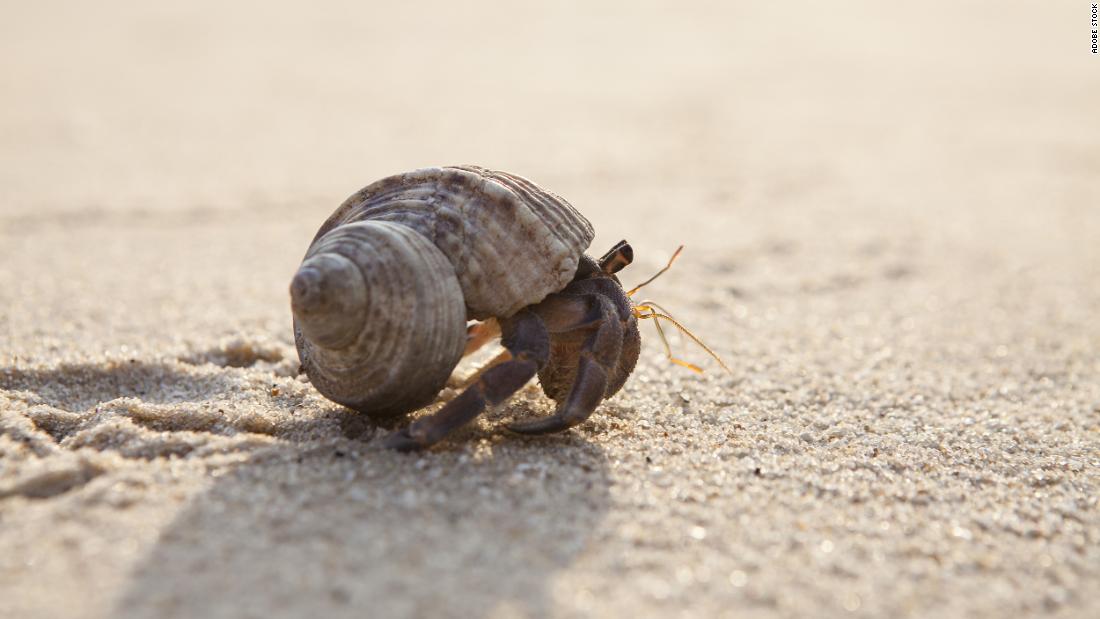Look at these furniture made from used plastic bottles 0:49
(CNN) -
Hermit crabs get into tires that have been disposed of in the ocean, and cannot get out, according to a new study from Hirosaki University.
The concave interior of a car tire can trap hermit crabs that flock there for food and shelter.
The study refers to this phenomenon as "ghost fishing", which refers to when marine animals are trapped in human garbage, such as fishing nets.
This was first noticed by Atsushi Sogabe, the study's first investigator and associate professor at Hirosaki University during a 2012 study in Mutsu Bay, Japan.
While keeping an eye on the needlefish along Mutsu Bay, he saw several shells on a discarded tire, some belonging to hermit crabs.
The Pacific Ocean is so acidic that it is dissolving the shells of these crabs
"I thought that the hermit crab that had invaded the inside of the tire could not escape due to the curved internal structure of the tire and consequently died," Sogabe said in an email to CNN.
"So I wanted to test this theory."
The hermit crabs' shells found in this study were badly damaged, and the researchers suggested this was a sign of cannibalism or competition for accommodation among the hermit crabs that had become stuck.
Through experiments in an aquarium and in the ocean, the researchers studied whether hermit crabs could escape from tires.
Over the course of a year, the scientists collected and released the crabs on a monthly basis, observing nearly 1,300 hermit crabs that became trapped in the tires.
(Don't worry - the hermit crabs were only used once and released near where they were collected.)
advertising
None of the hermit crabs that got into the tires were able to escape.
"The importance of this study is that it shows that not only the chemical and physical properties of the tire, but also its shape, can have a negative impact on marine life," said Sogabe.
Sea pollution: there are 14 million metric tons of microplastics on the seabed, according to a study
The scavengers of the sea
Hermit crabs are the "vultures of intertidal and marine environments," says Jennifer Lavers, Professor of Marine Sciences at the University of Tasmania.
They stir and circulate the soil on the shore, helping plants, such as palm trees, to spread and regrow.
In the ocean, they are scavengers and clean the seabed when other organisms die.
Crabs also rank at the bottom of the food chain for fish and shorebirds, providing a reliable source of food.
"If we lose these crab species or they are substantially less abundant, that has implications for sediment renewal. It has implications for regeneration and growth of forests. It has implications for cleaning up our beaches and oceans because potentially there will be no vultures. let them come clean things up, "Lavers explained.
Once tires reach the end of their "life cycle," approximately six to ten years, according to the National Highway Traffic Safety Administration, some are recycled into running tracks or new tires.
But many are thrown into the bodies of water.
A "bubble barrier" traps plastic waste before it reaches the sea
Its shape is not the only problem when the tires end up in the ocean.
Tire wear contributes up to 10% of microplastics in the ocean, according to a 2017 report by researchers from the Open University of the Netherlands.
Other forms of ocean and beach pollution, such as plastic bottles and containers, also harm hermit crabs.
Lavers led a 2019 study in the Cocos or Keeling Islands that found that hermit crabs mistook plastic containers for shells, causing one or two crabs to get trapped for every square meter.
Lavers notes that the new Hirosaki University study extends the research on entrapment to another part of the world, illustrating a problem "more widespread than we originally thought."
Abandoned fishing gear, such as nets and lines, can entangle larger animals, such as sea turtles: more than 300 were found dead off the coast of Mexico in 2018.
"Actually, this is likely to be a major problem," Lavers said.
"It's not just happening on beaches with drink bottles, but with various types of debris, including car tires, and it is likely affecting many more species in a variety of habitats that perhaps we did not originally anticipate."
They help sea turtles in Ecuador to rehabilitate 1:41
One tire at a time
But Lavers says he hasn't lost all hope.
Ocean conservation efforts, including recovering discarded tires or plastic bottles, may seem daunting on an individual level, but those actions can benefit the ecosystem by removing intact elements and reducing the risks of being trapped.
Removal of these objects can also prevent larger objects from breaking down into smaller pieces that animals can ingest.
"I think these crab trapping studies really validate and show the benefits to wildlife of doing these cleanups," Lavers said.
"There is a silver lining that I hope will give people the motivation and reassurance that the cleanings are worth it."
Sogabe said that while the hermit crab ghost fishing problem may seem less relevant in the face of climate change and microplastic pollution, even a single tire can pose a danger to ecosystems.
"This is a good example of how our casual behavior can have a negative impact on wildlife in unexpected ways," said Sogabe.
"It is important to realize that small changes in the behavior of each one of us can make a great contribution to the conservation of the environment."
pneumatic plastic in the oceans












